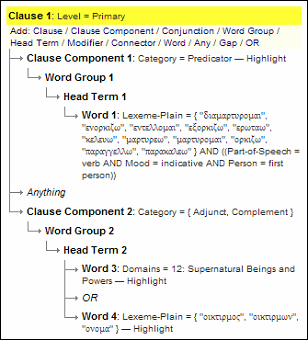Read the first five posts in this series: Intro | 1 | 2 | 3 | 4.
2Ti 4.1 offers an example of the Charge Form.
Charge Form in 2Ti 4.1
The discussion of this form is very much preliminary because Smith’s recent book, Timothy’s Task, Paul’s Prospect is the first to propose this form. If Smith is right, it could affect how one interprets the whole book of Second Timothy. One should at least weigh this when working through the book of Second Timothy.
Description of Form
Smith defines the form as follows:
My research has identified four basic elements which comprise the charge: the Charge Verb, Person/s Charged, Authority Phrase, and Content of the Charge. A fifth element sometimes present in a charge is the Implications of the Charge, though this is not a necessary component.[1]
Smith provides more explanation of each of these elements:
- The Charge Verb: Could be διαμαρτύρομαι, παραγγέλλω, μαρτύρομαι, ἐνορκίζω, εχορκίζω, ὁρκίζω, κελεύω, παρακαλέω, ἐντέλλομαι.[2] Smith notes these are to be active apart from deponents, which will occur in the middle.[3]
- The Person Charged: A second person singular or plural, though third person singular or plural are possible. The case of the noun is either accusative or dative. This item is not always a part of the charge, sometimes it may be implied from context.[4]
- The Authority Phrase: Typically following the verb, it may or may not use a preposition. When no preposition is present, the phrase uses the accusative case.[5]
- The Content of the Charge: Typically in a ἵνα clause and a verb second or third person subjunctive, though it may be an infinitival clause or perhaps even a series of imperatives.
Because the charge verb and authority phrase are always present, those will be used as the basis of the query.
The Form in OpenText.org SAGNT
Smith reports the following instances of the charge form: Mt 26.63; Mk 5.7; Ac 16.18; Ro 12.1-2; 15.30-32; 1Co 1.10; Eph 4.17; 1Th 4.1; 5.27; 2Th 3.6; 2Th 3.12; 1Ti 5.21; 1Ti 6.13-14; 2Ti 4.1-8.[6] The query follows:
Charge Form
- A primary clause with a first-person indicative charge verb as predicator. A second clause component, either an adjunct or a complement contains:
- “supernatural being or power” (Louw-Nida domain 12) as head term, or
- οικτιρμος, οικτιρμων or ονομα as the head term
This query, when run, returns 29 instances. Some are duplications based on the “OR” criteria in the word group of the second clause component.
- Instances from Smith located by the query: Mt 26.63; Mk 5.7; Ac 16.18; 15.30-32; 1Co 1.10; Eph 4.17; 1Th 4.1; 5.27; 2Th 3.6; 2Th 3.12; 1Ti 5.21; 1Ti 6.13-14; 2Ti 4.1-8
- Extras located by the query: Jn 14.16; 16.26; Ac 19.13.
- Instances from Smith missed by the query: Ro 12.1-2. This is due to a discrepancy in the annotation of Ro 12.1, where the prepositional phrase that functions as the authority phrase is annotated as modifying the following infinitive verb instead of the preceding indicative verb (the charge verb).
Bibliography
Smith, Craig A. Timothy’s Task, Paul’s Prospect: A New Reading of 2 Timothy (Sheffield: The Sheffield Phoenix Press, 2006).
Notes
[1] Smith, p. 27.
[2] Smith, p. 27, 29.
[3] Smith, p. 29.
[4] Smith, p. 30.
[5] Smith, p. 30
[6] Smith, p. 231-233






